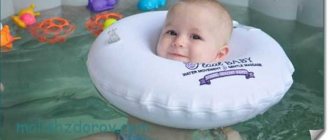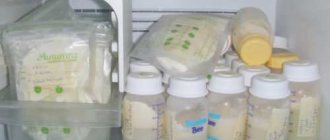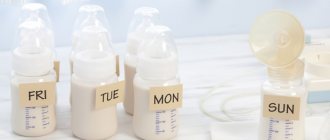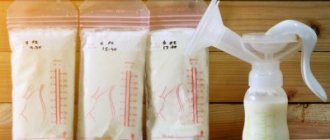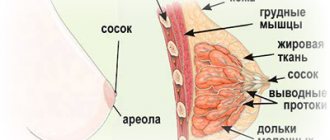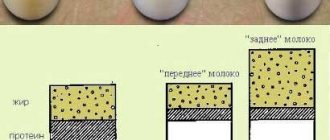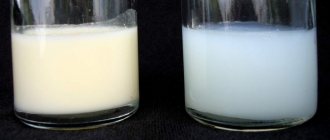Is it possible to put drops in a child’s nose?
Young mothers often use their own milk to combat children's runny nose.
It is assumed that immunoglobulins, together with protective cells, will quickly cope with the infection without harm to the child’s body. New parents refuse to use classical medicines, trying to protect the baby. Despite the benefits of mother's milk, it is not so harmless when introduced into the nasal passages of a baby. The only positive aspect of this treatment is hydration. The biological fluid softens the crusts and in the first minutes after instillation will make the baby's breathing easier.
The harm of treating a runny nose with this method has long had a solid evidence base.
- Milk is a nutrient medium, including for pathogenic microorganisms. When administered into the nose, favorable conditions are created for the growth of bacterial colonies.
- After a while, the curdled milk will begin to cause discomfort to the baby, disrupting his breathing.
- Liquid flowing into the nose under high pressure can enter the auditory tube. The anatomical structure of the ENT organs in children creates favorable conditions for this. This process leads to the development of an inflammatory process in the middle ear - acute otitis media.
Different types of runny nose
Runny nose or rhinitis is inflammation of the mucous membranes of the nose of infectious or non-infectious origin. The syndrome is accompanied by nasal congestion, copious discharge, sneezing, and decreased sense of smell. The acute form of rhinitis often leads to chronicity and complications from the respiratory system. Rhinitis in newborns is often caused by hypothermia, dry air, and insufficient hygiene of the nasal passages.
The modern classification includes more than a dozen causes of the development of a runny nose in newborns. Some subspecies, in turn, are classified in other areas. However, most often a runny nose in newborns is allergic, infectious and vasomotor.
Infectious runny nose
An infectious runny nose is a consequence of damage to the body and nasal passages by viruses, bacteria, and less commonly, fungus. Infectious rhinitis often complicates the course of other inflammatory diseases of the ENT organs. Injuries, anatomical defects, deviated septum, and others can contribute to the development of this type of runny nose in newborns (even with adequate hygiene and hydration).
The first symptoms do not differ from those that appear with other types of runny nose. However, after 3-4 days the discharge becomes cloudy, indicating the addition of a bacterial infection. This is accompanied by:
- increased temperature;
- deterioration of health;
- the appearance of “croaking” breathing;
- refusal to eat.
It is important to understand that the increase in symptoms and the development of complications in newborns and children under one year old occurs in a matter of hours or days.
Allergic runny nose
Allergic rhinitis is an inflammation of the nasal membranes as a result of exposure to an allergen. Allergic rhinitis is characterized by seasonality, but in babies under one year of age, multiple reasons can provoke an allergic reaction:
- dust;
- indoor and outdoor plants;
- reaction to medications, cosmetics, mother's perfumes.
The disease has a chronic course and goes away only after the provoking factor is eliminated. Often a runny nose is combined with conjunctivitis (lacrimation), a disorder of smell, and nasal congestion.
Treatment includes the prescription of antihistamines and symptomatic therapy. Children with a complicated allergic history should be observed by a pediatrician or allergist.
Vasomotor rhinitis
Vasomotor rhinitis is a chronic inflammation that occurs when the internal and neurovegetative regulation of the tone of vascular structures is disrupted. Various factors contribute to the development of vasomotor rhinitis. The pathogenesis of the disease is due to the regulation of vascular tone in the nasal passages.
Regardless of the type of runny nose, children need urgent and adequate treatment. Given some anatomical features and limited capabilities of the respiratory system of newborns, self-medication can lead to negative consequences, including death.
Dangerous sides
The main harm that breast milk can cause during a runny nose is an increase in the infectious environment. The product contains lactose, which is a favorable environment for the proliferation of pathogenic microflora. This leads to pathogenic runny noses, the presence of pus in the discharge and endless congestion.
When milk enters the nasal passages, the infection begins to spread throughout the child’s body – to the appendages and throat. Serious problems begin: pharyngitis, otitis media and sinusitis. All these diseases are very dangerous in infancy and are treated in a hospital.
Before dripping milk into your child's nose, consult your pediatrician.
How to cure a runny nose
Detritus in the feces of an infant - deciphering the coprogram
To treat a runny nose, it is recommended to use the methods proposed by traditional medicine: drip vasoconstrictor or antiallergic drops into the nose, use antiviral and antipyretic drugs, rinse the child’s nose, etc.
Treatment for rhinitis should be prescribed by a pediatrician
Despite the fact that rhinitis is not considered a serious disease, you should consult your pediatrician for treatment. The doctor knows best how many drops to put into the nose and how many tablets to use in a particular case.
Is breast milk healthy?
In the time of our ancestors, medicine could not boast of its development, unlike what is happening in our time. Diseases were treated only with traditional methods, recipes were passed down from generation to generation.
Mother's milk has always been used to treat children. They dropped it into the baby’s nose with a runny nose and waited for the illness to go away on its own. Adult residents also used such drops. The logic was obvious - if mother's milk is useful, then it is acceptable to use it for treatment.
This technique is often used to this day, but not every mother trusts it.
Medicine was able to refute the legend about the benefits of milk for treating a runny nose. Doctors say that breast milk has no effect on the treatment of rhinitis. In addition, it can harm the child:
- How to treat a throat with milk for colds, sore throat and other ailments in adults and children
- When milk gets into the baby's nasal passage, it blocks them. The situation is getting more complicated.
- Bacteria multiply remarkably in milk. This is dangerous and fraught with complications.
- The mucus in the baby's nasal cavity has stronger protective properties than mother's milk during lactation. Therefore, burying loses its meaning.
How to treat a runny nose?
Since milk is a rather useless and dangerous remedy, the problem must be eliminated by other methods. The disease cannot be left to chance. A child's nose must be thoroughly cleaned, since the baby cannot do this on his own.
How to quickly get rid of rhinitis:
- Take care of the environment. Monitor the temperature and humidity in the room where the baby lives.
- Regularly clean your child's nose from crusts and mucus accumulations.
- Disinfect the nasal cavity.
- Watch your breathing through your nose.
Possible complications after a runny nose
Prolonged runny nose inevitably leads to chronic rhinorrhea and its complications. Typical complications that pathology can lead to are:
- sinusitis;
- pharyngitis;
- inflammation of the middle ear or otitis media;
- bronchitis;
- pneumonia.
Laryngitis practically does not develop in children under one year of age, but when it occurs, it has an extremely aggressive course and requires immediate treatment. In most cases, complications are treated in an inpatient setting.
Atypical complications include:
- dacryocystitis - an inflammatory process in the tear ducts with suppuration from the eyes, itching, irritation;
- polyps are benign neoplasms in hypertrophied areas of the nasal membranes and sinuses;
- hyposmia - decreased sense of smell with a further decrease in sensitivity to odors.
Chronic runny nose complicates the development of the child, leads to a decrease in the frequency of pronunciation of sounds, drooling, and a nasal voice due to forced compensatory breathing through the mouth.
Breast milk for a runny nose: pros and cons
The older generation and traditional healers explain the positive effect of breast milk for a runny nose by the fact that it includes maternal antibodies, which help the baby’s body resist viruses and bacteria. Indeed, a large amount of milk immunoglobulins helps to form the baby’s immunity, but only when the newborn eats it.
Dripping milk from a runny nose can only worsen the child’s condition
Once on the mucous membrane of the nose, milk antibodies do not protect the body from infections in any way, since they work only in the blood plasma. Breast milk for a runny nose can “help” in cases where this illness would have gone away without treatment. It softens dried crusts, but even for this there are many other effective ways. This means that grandmother’s advice to drip breast milk into your nose when you have a runny nose can be called harmful.
INTERESTING: how to freeze breast milk: using bags and containers
Should I put it in my eyes or nose?
Grandmothers recommend that young mothers drip breast milk into the baby's nose with a runny nose at each feeding. The more often the procedure is performed, the faster the child will recover. In reality, everything is not like that. Modern pediatricians, ophthalmologists and otolaryngologists tell us why conjunctivitis and rhinitis in a newborn cannot be cured with breast milk.
- Breast milk is a nutritious liquid that contains various beneficial components. It is considered an ideal food for a child and helps to form strong immunity due to its antibody content. However, a woman's milk is not capable of destroying bacteria and viruses. It works inside the body and has no local antiseptic effect. Therefore, pouring breast milk into a baby’s nose is simply pointless.
- The mucous membrane of the nasal cavity cleanses itself due to the ciliated epithelium and secretory activity. The mucus produced flushes out harmful microorganisms and protects the inner lining of the nose. If you drop milk into a child's nose, the eyelashes will stick together. They will no longer be able to remove mucus and cleanse the nasal cavity. This can lead to complications. Therefore, using such a treatment method is dangerous.
- Human milk contains sugars. They create a favorable environment for the growth of bacteria. If you regularly carry out this procedure, an infection will appear in your nose. For the same reason, you should not put milk in the eyes of a newborn. Unconventional treatment methods will lead to dangerous bacterial diseases.
We can conclude that treating a runny nose using an unconventional method is ineffective and dangerous. Therefore, you should not self-medicate. It is better to take your child to the doctor and find out if the use of medications is required.
Many mothers say that breast milk helped their baby with a runny nose. Modern pediatricians explain this simply. In the first years of life, the child’s body encounters various infections, most of which are viral in origin. The baby's immunity, especially with proper organization of breastfeeding, copes well with diseases on its own. Recovery occurs within one week.
Therefore, the child who had breast milk dripped into his nose recovered not because of the unconventional method of treatment. He simply recovered on his own, despite regularly putting milk in his nose.

